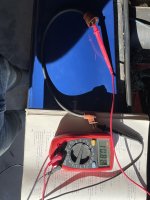It may or may not be - high voltage can act really unpredctably at times.
I'd start by looking at the points - if they are pitted or corroded they won't give the coil enough current thru the low voltage side to build up the magnetic field necessary to generate the high voltage pulse when collapsing, thus a weak or non-existant spark.
I had problems on a 1972 MGB where the coil itself was failing on the low voltage side and drawing too much current, causing the plastic follower that rides the distributer lobes to get soft and bend, resulting in a decreasing-gap situation that just caused yet more current to flow, the plastic to get hotter and eventually just melt. A new coil solved that one.
If the points appear clean and properly gapped, make sure you are really getting a full 12V to the coil - if you have a high resistance in any of the connections from the ignition switch to the coil it will also result in a weak spark.
Lastly the rotor and cap - if they are worn (or wet/dirty inside) you can lose too much spark energy there. Check for spark by placing the coil to cap wire near a good ground and crank it. Probably don't want to be holding it in your hand or with a metal tool - a safer way is to clamp a spark plug to a convenient bracket on the engine (metal to metal) with a vice-grip and connect the coil wire right to that plug - if it sparks healthy you have good action in the points and coil. If doing the same test off one of the output plug wire ports on the distributer fails to yeild a spark then you know the problem is in the cap/rotor unit portion.

 Hi Guest!
Hi Guest!

 smilie in place of the real @
smilie in place of the real @
 Pretty Please - add it to our Events forum(s) and add to the calendar! >>
Pretty Please - add it to our Events forum(s) and add to the calendar! >> 
